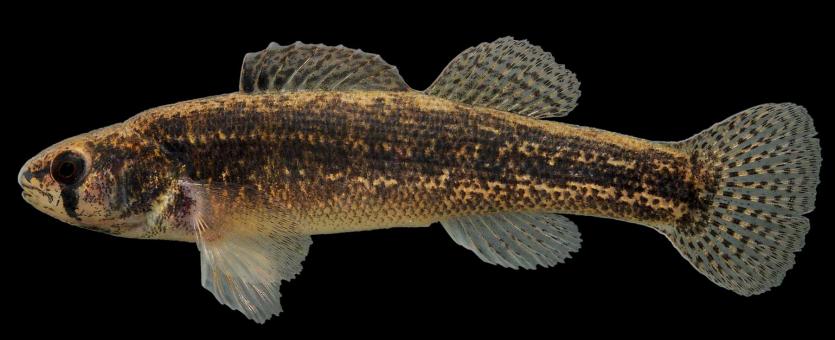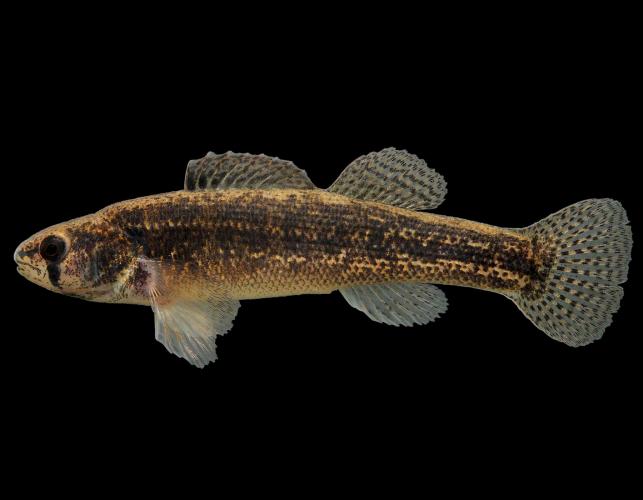
The goldstripe darter is a rather stout, mottled-brown darter without definite crossbars on the back. A useful character for identifying this species is the pale stripe that usually is evident along the lateral line. A dusky vertical bar appears on the cheek beneath the eye. The back is a more or less uniform light brown, contrasting with the dark brown and more definitely mottled sides. The belly is yellowish. All fins except pectorals banded with brown lines.
The gill covers are broadly connected by a membrane across the throat. The midline of the belly is without enlarged and modified scales. The lateral line is complete or nearly so, extending well beyond the soft dorsal fin.
During breeding season, breeding males lack bright colors, but when they engage in aggressive encounters and spawning, they may develop a series of black vertical bars along the sides; also, the black bar under the eye darkens, the eyes turn bright red, and the dorsal, anal, and pelvic fins become black.
Length: adults about 2½ to 3 inches.

Known in our state only from Romine Spring in Butler County, and from three locations in or near Holly Ridge Natural Area in Stoddard County. All locations are in southeastern Missouri.
Habitat and Conservation
The goldstripe darter has rather specialized and exacting habitat requirements, and its few locations in southeastern Missouri fit the bill — small, shallow, spring-fed streams with low to moderate gradient, with a sandy bottom and a dearth of rooted aquatic plants due to the shade from trees above. Within such streams, this fish hides among twigs, leaves, and other detritus in sandy areas with lighter current.
Food
Goldstripe darters eat a variety of arthropods (jointed-legged invertebrates), including the aquatic larvae of flies, midges, caddisflies, and beetles, as well as small crayfish.
Status
One of the rarest Missouri darters, the goldstripe is a Species of Conservation Concern and is considered Endangered within our borders. Although it has never been abundant in our state, its presence is jeopardized by excessive siltation, restriction of channel flow, water impoundment, and removal of the tree canopy that helps keep the water cool and clear of algae. Agricultural and urban development have lowered the water table and added pollutants to the water.
Life Cycle
Breeding probably occurs in March, April, and possibly into May. The strongly adhesive eggs are attached singly to plant stems, leaves, and other structures.
Human Connections
Missourians can be proud of our state for many reasons. One bragging point we have over most of the neighboring states is the richness of our fish community, including rare types like this darter. There are more than 200 kinds of fish in our state. Kansas, for example, only has about 140.
Ecosystem Connections
Darters are adapted for life in the swift-flowing sections of clear, rocky streams. Their swim bladders are reduced or absent, so they don’t float away, and their enlarged pectoral fins help them cling to rocks. With their unique place in the stream, they have a special ecological role, too.




























